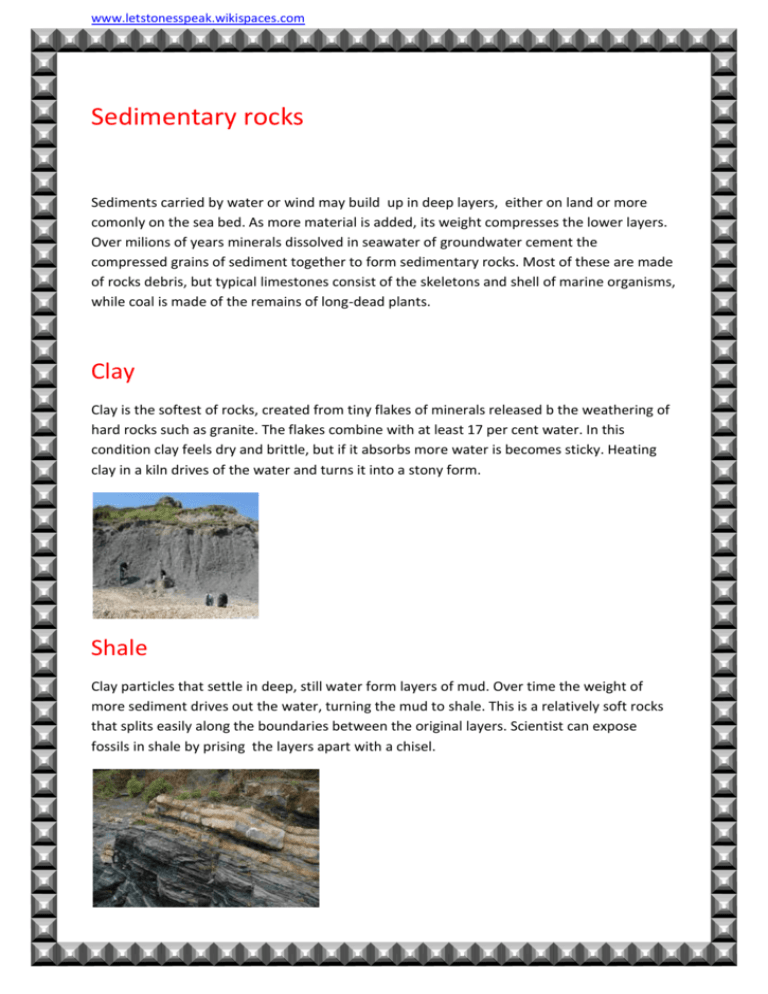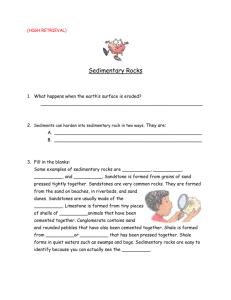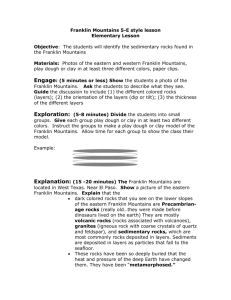Sedimentary rocks. (1) - Letstonesspeak
advertisement

www.letstonesspeak.wikispaces.com Sedimentary rocks Sediments carried by water or wind may build up in deep layers, either on land or more comonly on the sea bed. As more material is added, its weight compresses the lower layers. Over milions of years minerals dissolved in seawater of groundwater cement the compressed grains of sediment together to form sedimentary rocks. Most of these are made of rocks debris, but typical limestones consist of the skeletons and shell of marine organisms, while coal is made of the remains of long-dead plants. Clay Clay is the softest of rocks, created from tiny flakes of minerals released b the weathering of hard rocks such as granite. The flakes combine with at least 17 per cent water. In this condition clay feels dry and brittle, but if it absorbs more water is becomes sticky. Heating clay in a kiln drives of the water and turns it into a stony form. Shale Clay particles that settle in deep, still water form layers of mud. Over time the weight of more sediment drives out the water, turning the mud to shale. This is a relatively soft rocks that splits easily along the boundaries between the original layers. Scientist can expose fossils in shale by prising the layers apart with a chisel. www.letstonesspeak.wikispaces.com Conglomerate Most sedimentary rocks are made of small rock fragments or mineral grain, but conglomerate consist of big pebbles that have been cemented together. The rounded pebbles were once transported by water, and they are often the remains of an ancient beach. A similar rocks, breccias, is made of sharp-edged stones once carried by ice. Evaporites These rocks are formed by the evaporation of water that contains a lot of dissolved minerals. As the water vapour is driven off, the minerals stay behind. Evaporating seawater, for example, can leave thick salt deposits, which may then be buried and compressed into rock salt. . Limestones Marine organisms absorb dissolved chalky minerals from seawater and use them to build their skeletons and shells. When they die the chalky, calcareous materials survives decay and www.letstonesspeak.wikispaces.com build up in layers on the sea bed, Over time, the layers may be compressed into chalk or limestone, which often contains visible shell fragments. Flint Chalk is a soft white limestone made of the calcareous skeletons of countless microscopic marine organisms that live roughly 100 milion years ago in a shallow tropical sea. In often contains nodules of hard black flint, which probably formed from the glassy skeletons of other organisms such as sponges. Flint is very like glass, fracturing to produce razor-sharp edges, and was widely used by early humans to make stone tools . Coal If plant remains accumulate in waterlogged, airless conditions, they turn into peat. If the peat is buried deep beneath more sediments, it can be compacted and heated to form coal-a black, shiny rock then can be burnt as fuel. The oldest, hardest coal, formed from plants that lived some 300 milion years ago, is almost pure carbon. www.letstonesspeak.wikispaces.com . Answer the questions: 1. Name some of the most known sedimentary rocks. _________________________________________ 2. How are sedimentary rocks formed? _________________________________________ 3. Which rock consist of big pebbles ? _________________________________________ 4. What is chalk? _________________________________________ 5. Which of sedimentary rocks can we burn? _________________________________________









